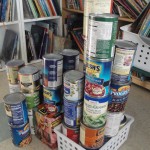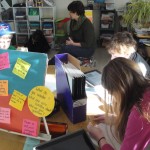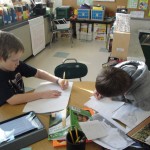I hope you are all back in power after yesterday’s bluster. It seems as though things are settling down here as I write this. The moon is bright and shining now, but I wonder how many of the children will have the chance to see it. Thank you for your help with this project. The children really seem to enjoy noticing phases of the moon change and what and when the moon is in the sky. It is fun to stop and notice more carefully. I hope you enjoy the lab too – I know it was a surprising project for me when I first did it three years ago.
Moon Labs – Learning More about the Scientific Method
The Moon Observation Lab is the first to two different space labs that we will be doing during this unit of study. Through them we hope to help the children learn about the different parts of a science lab. In these two labs most of the parts – question, procedure, materials and observation data charts – are set up for the children. They are responsible for stating their hypothesis as clearly as possible, gathering the nightly data and writing their conclusion. (We’ll do that in the classroom after vacation – I am aware of that time glitch. We’ll do the best we can.)
In the classroom next week we will be conducting a Crater Lab that will include all of the steps. We will be adding that into the moon observation book as well. Our hope is that this work now will help the children be more aware of the scientific method and the formality of science labs. They will be doing more and more of them as they progress through the grades.
We have continued working to notice and collect thinking as we read. We have been visualizing and wondering. We are working to deepen our understanding of what visualizing means – mind pictures and movies are only part of that strategy. We are adding the notion of empathy and working to become more aware of our other sense as we read too.
We have been comparing our thinking and considering if there is a difference when we are working to understand fiction or nonfiction. We learned that it is easier to remember facts and understand them if we can connect them to what we know or make a reference to something else. For instance it was surprising and memorable to know that some craters on the moon as so large you could fit the entire city London in them. We also learned that if we could drive a car to the moon, it would take four months to reach it.
The children have been working to keep track of thinking during read aloud. They have also been noting their “inner voice” as they read independently. When you read with your children you might want to share your thinking with them and see how it compares. I am often surprised and delighted by how they think and how they put those ideas into words to share. Thinking about thinking and reflecting to add to understanding is an interesting process.
Learning More About Research
Space and Personal Choice Topics
Last week when the children came back to school after the museum, they were excited and ready to launch into the next round of research. They knew their topics right away and were already thinking about how they would build their displays. They reflected on their work and their research. Many of the children felt they would like to have more information though they weren’t sure how that might happen. Some of them knew that all they shared had not been completely accurate nor was it written in their own words based on their thoughtful understanding. To help with this we are going to have weekly check-ins and write back and forth to each other. Sometimes I will be writing to the children and they will be responding. Other times they will be writing to each other. We hope this will help with the research process and give the children more opportunity to think about and share what they are learning – and what they might want to find out – along the way.
On top of this independent research work, the children learned that we would also be researching space topics too. We wondered if we could do two projects – would we be willing to put in the effort? How would we want to present the work? The children overwhelmingly want to do both projects and they would like to share their work in the museum format. They really enjoyed sharing and being in the role of expert. So we are going to give that a try – one museum in early March and another in April.
Bits and Pieces –
- We continue to work with multiplication and mastering basic facts. We are working with measurement and fractions as we deal with the dimensions of space. We are nearly finished with The Chronicles of Wildwood – we may even finish it today. This is a trilogy. The second, Under Wildwood, has been published. If you read together as a family it would make a great read-aloud – though I don’t think it would fit well for younger children. It is a fantasy and some of the “evil” side is just that, evil.
 Thank you so much for supporting our 100 Day collection. We are definitely approaching goal and have many cans of beans.
Thank you so much for supporting our 100 Day collection. We are definitely approaching goal and have many cans of beans.- February 11 – Stargazing Night – Please save the night and hope for clear weather. Look for the details and information about telescope etiquette to share with your 3rd grader so we’ll all have an exciting, rewarding evening.
- February 14 – We will begin our day with a Valentine’s Day Breakfast and share our cards with each other right as the day begins.


